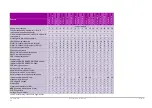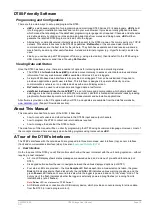
UM-0085-B09
DT80 Range User Manual
Page 23
RG
The exact function of each terminal varies depending on how the channel is programmed. In general terms:
•
The * ("Excite") terminal can be a voltage input (relative to # terminal), or it can provide sensor excitation (for
example, for resistance measurement) See
•
The + ("Plus") terminal is a voltage input (relative to – or # terminal)
•
The – ("Minus") terminal is a voltage input (relative to # terminal)
•
The # ("Return") terminal is normally used as a common or return terminal. It can also be used as a current
input, using the DT80's internal shunt resistor.
Figure 3: Analog input channel terminal labels
Multiplexers
The DT80's analog input channels are
multiplexed
. The required input terminals are first connected to the input of the
DT80's instrumentation amplifier and analog to digital converter, then a measurement is taken. The next channel to be
sampled is then switched through to the amplifier and ADC, and so on. Simultaneous sampling of analog channels is not
possible.
Channel definition commands
in the DT80 program determine which terminals are used for a particular measurement.
For example, the channel definition
1+V
measures the voltage between the + and # terminals on channel 1.
Gain Ranges and Attenuators
The DT80's instrumentation amplifier has three switchable gain settings. These give three basic voltage measurement
ranges (3V, 300mV and 30mV full scale)
The DT80’s default is for its instrumentation amplifier to automatically change gain range to suit the input signal applied
to it by the multiplexers.
If the amplitude of your input signals are known, then the gain can be set manually. Do this by applying the
GL
x
(gain
lock) channel option, which disables autoranging for that channel and sets the gain to a fixed range.
The analog inputs also include switchable 16:1 (10:1 for Series 3 or older)
attenuators
, which effectively provide a fourth
range.
Warning:
Maximum input voltage on any analog input is ±50V dc (±30V for Series 3 or older), relative to the
AGND/EXT#
terminal. If
this is exceeded then permanent damage may occur.
Analog Input Configurations
The basic quantity that the DT80 measures is voltage. Voltages can be measured using two different input
configurations:
•
shared-terminal analog inputs
•
independent analog inputs
Shared-Terminal Analog Inputs
Sometimes called "single-ended" inputs, a shared-terminal input is one that shares one or more of its terminals with
another input. In
, the three sensors share channel 1’s # terminal. Each of the three inputs is a shared-terminal
input.
Figure 4: Shared-terminal voltage inputs sharing a channel’s # terminal (voltage inputs used as example)
















































